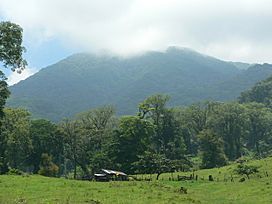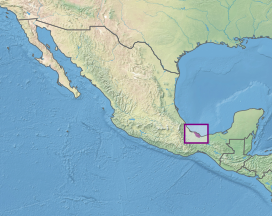Sierra de los Tuxtlas facts for kids
Quick facts for kids Sierra de los Tuxtlas |
|
|---|---|

Cloud-shrouded San Martin Tuxtla
|
|

Location of the Sierra de los Tuxtlas
|
|
| Ecology | |
| Realm | Neotropical |
| Biome | tropical and subtropical moist broadleaf forests |
| Borders | Petén–Veracruz moist forests |
| Geography | |
| Area | 3,813 km2 (1,472 sq mi) |
| Country | Mexico |
| States | Veracruz |
| Conservation | |
| Conservation status | Critical/endangered |
| Protected | 1,519 km² (40%) |
The Sierra de Los Tuxtlas are also known as the Tuxtlas Mountains. They are a chain of volcanoes and mountains located in Eastern Mexico. You can find them along the southeastern coast of Veracruz, next to the Gulf of Mexico.
A special protected area called the Los Tuxtlas Biosphere Reserve covers the coastal parts and higher areas of these mountains. Long ago, the ancient Olmec people used these volcanic mountains. They took a type of rock called basalt from here. This was during the Early Formative period, from about 1500 BCE to 400 BCE. The Olmecs moved the basalt by raft through rivers. They used it to create large monuments, including their famous colossal heads.
Mountain Peaks and Volcanoes
The Sierra de Los Tuxtlas has several important peaks. Two of the highest are Volcano Santa Marta and Volcano San Martín Tuxtla. Both of these volcanoes rise more than 1,700 meters (about 5,577 feet) high.
Volcano San Martín Tuxtla is the only volcano in this area that has erupted recently. It erupted in 1664 and again in May 1793. It is a wide, dome-shaped volcano with a large crater at its top, about one kilometer wide. There are also hundreds of smaller, cone-shaped volcanoes scattered throughout the Sierra.
Other volcanoes in the range are no longer active. These include San Martin Pajapan, which is 1,160 meters high, and Cerro El Vigia, at 800 meters.
The volcanoes of the Sierra de Los Tuxtlas are quite unique. They are separated from other volcanoes by long distances. The nearest volcanoes in the Trans-Mexican Volcanic Belt are about 250 kilometers (150 miles) to the west. The volcanoes of the Central American Volcanic Belt are almost 330 kilometers (200 miles) to the southeast.
Amazing Nature and Wildlife
The higher parts of the San Martin Tuxtla and Santa Marta volcanoes are covered in a special kind of forest. This is the Sierra de los Tuxtlas tropical rainforest. It is part of the Neotropical region and is a type of tropical and subtropical moist broadleaf forests. The lower areas of the mountains have shorter grasses and pastures.
This region is home to some very special animals that live nowhere else.
- The Tuxtla quail-dove (Zentrygon carrikeri) is a bird found only in this rainforest.
- The Volcan San Martin rainfrog (Craugastor vulcani) is an endangered frog. It lives only in the rain and cloud forests of the Sierra de Los Tuxtlas.
- A giant scarab beetle, Dynastes moroni, was discovered here in 2005. It is also found only in this area.
See also
 In Spanish: Sierra de los Tuxtlas para niños
In Spanish: Sierra de los Tuxtlas para niños
- List of ecoregions in Mexico

